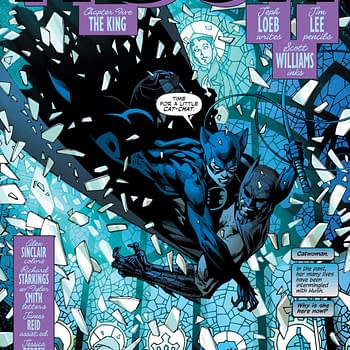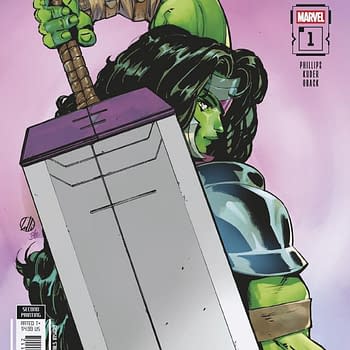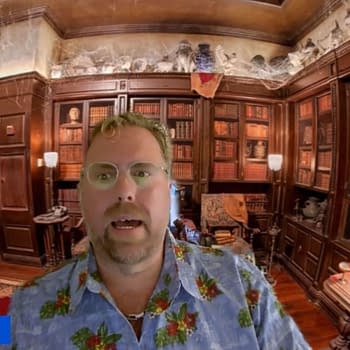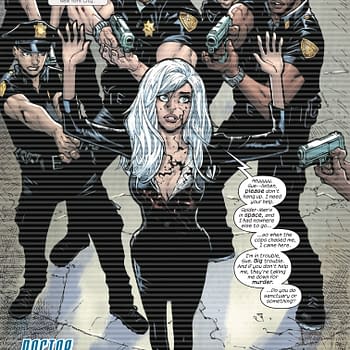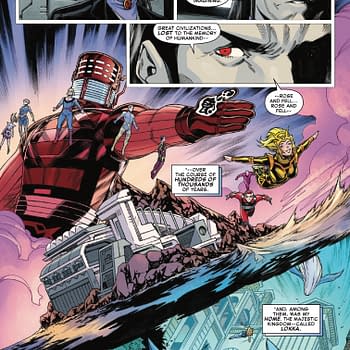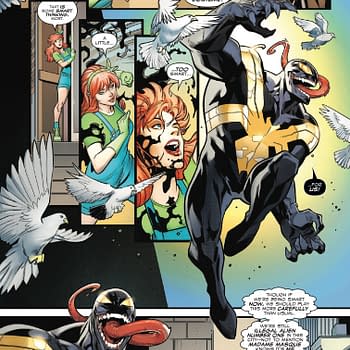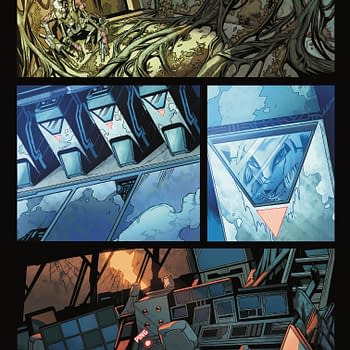Posted in: Comics | Tagged: Comics, cory childs, denver comic con, HRL, leylines, robin childs, wavemen
Robin And Cory Childs Talk New Series 'Wavemen' At Denver Comic Con
Neil Greenaway (of Nerd Team 30) writes:
Robin and Cory Childs have been fixtures on the Colorado convention circuit for years. Watching their web comic LeyLines transform into a series of graphic novels has not been a long ride at all. I saw the pair last weekend at Denver Comic Con 2017 with the recently released fourth volume of LeyLines and the first volume of a new series, called Wavemen. The time seemed right, so I sat down to talk with them about where the story came from, where it's going, and how the couple work so well together.
Bleeding Cool: I am standing here with Robin and Cory Childs talking about their series LeyLines. Can you start by bringing our readers up to speed on what the series is about?
Robin Childs: Absolutely! LeyLines is the story of three siblings who are on the run from a conspiracy that claimed their mother's life. In the process of fleeing their assassins and the machinations of those that would harm them, they wind up stumbling onto the schemes of the Gods themselves. Ultimately they will be forced to choose between their future and their family. There is a lot of mystery and mysticism and magic, but ultimately it is about who you are and who you choose to become.
BC: How many books into the series are you now?
Robin: We are four books in now. We just released volume four this year. The story also continues online, so there is always a portion of it that is ahead of what's printed. But the books come with all sorts of little extras for those world-building people who love that nitty-gritty stuff.
BC: So you put this out as a graphic novel, and you've said that it was released as a web comic as well. Have you ever considered printing some traditional single issues?
Robin: Actually we have a new series (called Wavemen) that we are approaching from the single-issue perspective. Where LeyLines is content online first and then in book format, Wavemen will be done in sort of the reverse of that — with single issue individual episodes. We're building it like a TV series, where there is a continuing story, but you can enjoy each individual piece on its own as a stand-alone story.
BC: Does Wavemen tie into the LeyLines story at all, or is it in a separate universe?
Robin: They are each in their own separate universe. I will actually let Cory tell you a little more about that, because he is definitely the head honcho on that project.
Cory Childs: Wavemen is a project I've been working on for quite a while now. I think I had the original idea back in 2008. My folks originally came from Hawaii, so I grew up with a lot of Eastern fairy tales, mainly Japanese. I was on the trip back home visiting my grandparents. We were taking a drive in the countryside, and I was remembering all of those stories that I grew up with. I thought, what if all of these legends that I grew up with were on a team and they fought supernatural crime? That was where this story was born, but it has been through a million iterations. Then two years ago at this show, Denver Comic Con 2015, we met a man named Jonas Goonface who ended up being our first artist on the project. From there it really took off, and it has come into its own since then.
Robin: Jonas is actually working on a new project right now for Boom! Studios called Godshaper, and I highly recommend that everyone go check that out.
BC: You have said that you both work on LeyLines. What is the division of work on that?
Robin: Cory is my editor. I am the writer and the illustrator, but occasionally I will write myself into a corner. I go to him saying "Help," and he figures out what to do. Also I am a very verbose writer, and getting a page down to the minimum amount of dialogue needed is a specialty of Cory's. So I will ask him to take the "red pen of death" to my scripts.
Cory: Yeah, I do a lot of content editing, rather than things like punctuation. My specialty is really just focusing the story. It's really easy to let a tale get away from somebody and sometimes complexity is confused for a compelling story. It's my job to re-focus and make sure that the big thing we want to communicate in the story is the thing that comes across. So that is primarily my function in LeyLines. We joke around that I'm the editor so if anything is wrong it is clearly my fault. That is kind of how we let people know what we do on the project. But Robin is the driving force behind it. It's her brainchild. It's something she has always taken point on both in terms of the art direction as well as the storytelling and writing.
BC: Cory has given me a little background on where Wavemen comes from; where did the story of LeyLines come from?
Robin: Oh man. There are so many different influences for it. I view LeyLines as the project where I finally admitted to myself that comics were something that was a passion of mine. I had been doing comics before that starting when I was 15. I worked on a project for eight years and finished it after 800 pages, but I came from a family where my dad was an engineer, therefore I was supposed to be one too. I really repressed any sense of passion, any sense of what I care about. So if you had asked me "Is this something you want to do?", I would say "Oh no, this is just a hobby." Well, I finished that "just a hobby" project and said, OK, now I can get to my real life and get a real job. About two weeks later I felt like I was just drowning. I realized at that point that this wasn't just a hobby. This was something I always cared about, was always passionate about, and I was going to be doing comics for the rest of my life. That is when I started LeyLines; that's when I started my own company with Cory.
LeyLines at its core is "could you choose between your future and your family?" There's a reason that's the core of that story, because I had to make that choice, and it's not an easy choice. It's a complicated one. How you define family and how you define your own future varies drastically from person to person. That is my way with every character — exploring different ways to view what it means. Can you balance that question, is there a way to have both or is it truly a binary? That is the personal background for it.
Inspiration wise, I love mythology and history and I'm just always consuming more. All of that stuff just sneaks in there and people will ask "Is this based on Mayan, is this based on Japanese?" I say, "I studied that at some point, so I am sure that it's in there somewhere. Whereas with Wavemen I do a ton of research to make it period accurate. We don't use myths that don't have their origins around that time or before or it can't justifiably be said to possibly have existed at that time period. We are incorporating real historical figures into the story. If you have studied history, there are spoilers, but we chose an era that is not explored that often. So I think that will help people discover all this amazing history we have learned as we work on this project.
Cory: Yeah. Wavemen is something we have set in Japan. The year the first episode takes place in is 884. Most people are very familiar with the warring state periods, where there were a lot of Samurai fighting each other. This takes place about 800 years before that. This era is really defined by its peace, by its cultural growth, and as a result a lot of the mythology that we are delving into got its origin in this period. For us its really cool to have these historical figures and these mythological figures living side by side, affecting each other. The supernatural world having an impact on real history and history having an impact on the supernatural world. That is one of the big things we wanted to explore with this series.
BC: If you are writing that one, Cory, do you have any part in that Robin? Are you the artist?
Robin: I am not the artist, I am the co-writer. It took us five years. The only thing we ever fight about in our marriage is writing, because we have such drastically different styles that we would butt heads constantly. But after five years of trying, we finally figured out how to work together as a team. I think we make some of our best work as a result because where I'm strong he's weak, and where he is strong I am weak so we have learned to just hand it over to the other one and say this is your thing, go make magic and then we will workshop it afterwards.
I also kind of take on the role of director because the artist will send me back their thumbnails, and I will take that and say "OK, like this, don't like that, change that, flip that, try this angle." I've built so many 3D models in Google SketchUp! It's funny because half the time I don't know that I (as an artist) could do what I am asking them to do and I might have to scale it back. Then there is always silence for a day and then they come back and they have made something that is just jaw dropping and gorgeous.
Cory: That has really been the theme of this project: challenge. It's something that we have really pressed for in ourselves in the writing and definitely something that we were asking our artists to step up to the plate for and they have delivered.
Robin: Jonas Goonface has always been amazing. He was the first one to sign on to the project. Jackarais of Bicycle Boy, too. The detail he puts into every page is just stunning.
BC: Will he be the artist on the second story?
Robin: One of the things we want to do is actually work with different teams. I would love to work with him again, but I think for our next project we might try to see if we can get another set of artists. When we started this project our favorite comic of all time was Lucifer from Vertigo and Lucifer had a different set of artists for different arcs and it felt like they always paired just the right artist for that particular piece. We kind of thought that was a really neat idea and we wanted to bring that energy to it. That's part of why the first issue has both the artists working on it.
Joel Mercer is the third one because we wanted people to get used to seeing different art, so that it wasn't shocking. People get really set, when it comes to artists on books. But if you introduce that concept early it sort of says "This is what's normal, so chill." We are always going to make sure the quality and the skill level is high. I'm always going to challenge artists to do well and their best work but we want them to bring their own spirit, their own voice to the project.
I think part of the fun is we have an idea in ours heads of what it should look like and then you get back something that is totally different. Or the artist will think that pacing wise we might benefit from and extra page here or a little chunk here. We will actually edit and change the script based on their notes and suggestions. Or there will be little details. I know this is really small, but there is a sandal that one the characters wears. They are grabbed and flung across the room and a sandal comes off in one of the images and Jackarais kept that sandal consistent as it appears over and over. It's just a tiny little detail, but it's the consistency like that that just really makes it feel so real. It sounds so silly to say out loud, but I love that sandal.
BC: Now you had said that LeyLines was released as a web comic, is there a date yet for releasing Wavemen as a web comic?
Cory: We originally released LeyLines as a web comic and it is still continuing as a web comic. You can find that at LeyLinescomic.com. As for Wavemen we are still a little bit in limbo. It was originally decided to be a web comic, but right now we are seeing where the project will go and what it wants to be before we release it. I think it will probably still be a web comic, but I would like to get a leg up on episode two before we really pin down an initial offering for it.
When we originally designed this project, I wanted a full episode out online ready to go before we even started with a second episode so you have a story, you have an arc ready to go. You can enjoy that fully before you come to the end of the archive. So now we've got episode one done. Episode two is written, we just have to line up that art and work with the people who will bring the best tone to the project. As soon as we do that, we will decide where it's going to go.
BC: With LeyLines, how often do you guys come out with a new book?
Cory: We try to do one once every year. The first one was 120 pages of full color and the second book is about 20 pages longer.
Robin: I am actually thinking about making bigger more omnibus style books because one of the things we are running into is this series could easily be 10 books long. That's a lot of books to haul around to shows. So if I made thicker books people could get more satisfying chunks, which might be a direction I move. It's one of those things where you are constantly learning, constantly changing and trying new things and you just learn as you go. Hindsight is 20/20.
BC: I think that wraps up my questions except for this last one. We know about LeyLinescomics.com where else can people find your work online? Where can they see what's going on?
Robin: So if you're on social media you can follow me on Twitter @robinoflaylines. I love Twitter — it's probably the place I am most active because I love to talk and it forces me to get it done in 140 characters, so it's a great writing exercise for me. I'm on Facebook, I'm on YouTube, I actually do weekly vlogs on Patreon. Then we also have mokopress.com; it is kind of our central hub. We have a link to the story there and a link to my other services too, because I do commission work, I do editing. I think that is everything.












